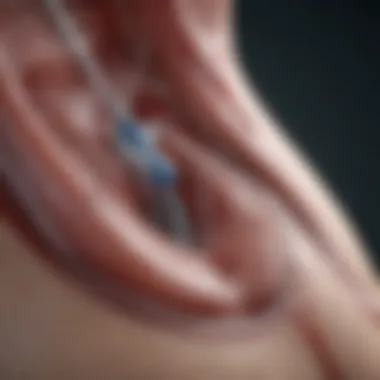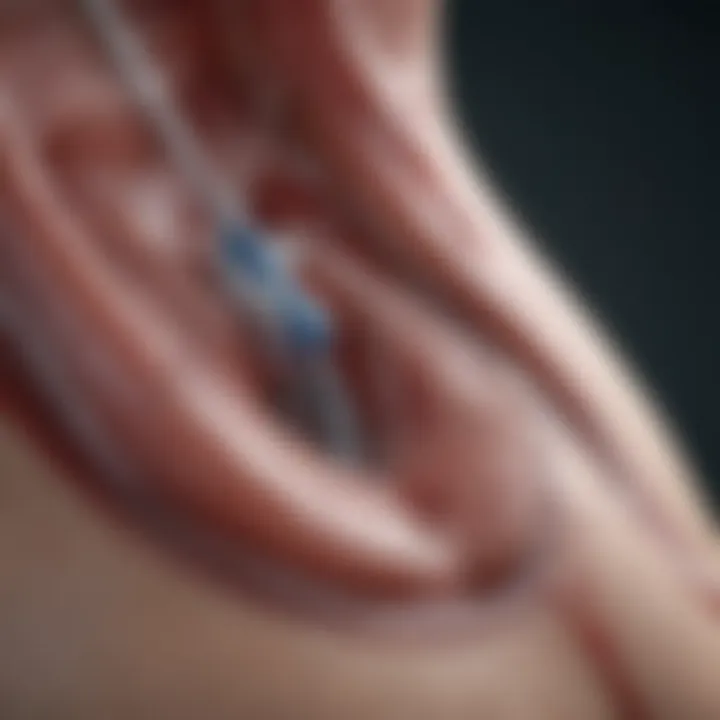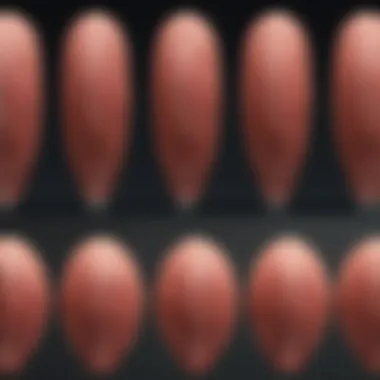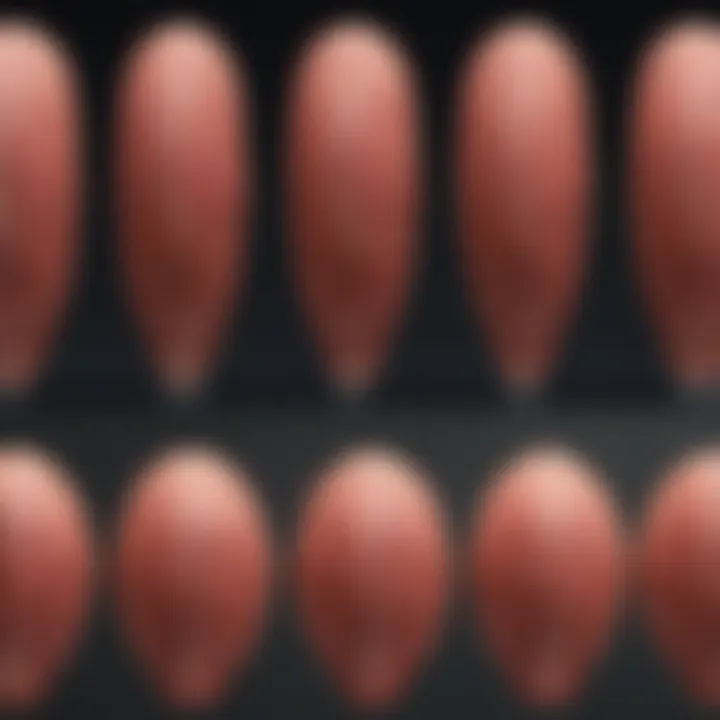Advancements in Vascular Closure Devices


Intro
Vascular closure devices (VCDs) have transformed the management of arterial puncture sites following invasive procedures, like catheterization. Their development is crucial as they offer improved safety and significantly enhance patient outcomes. As we explore this topic, it becomes apparent that the innovations in VCD technology reflect broader trends within the healthcare sector aimed at improving procedural efficiency, reducing complications, and optimizing recovery times for patients.
Article Overview
In this section, we will summarize key findings related to the recent advancements in vascular closure devices. This examination will highlight the mechanisms of action, comparative effectiveness, and the various clinical applications of these devices. We will also outline the future directions in VCD technology, which may hold promises of even greater improvements in patient care and surgical practices.
Summary of Key Findings
- Mechanisms of Action: VCDs operate through several different mechanisms, including sutures, plugs, and sealants. Each method has unique advantages and implications for use in various clinical contexts.
- Comparative Effectiveness: Studies indicate that certain VCDs may provide faster hemostasis than traditional methods, such as manual compression, thus reducing the time patients must remain under intense observation.
- Clinical Applications: The device utilization spans numerous fields, particularly interventional cardiology and vascular surgery. Their significance in these specialties cannot be overstated, as they facilitate earlier mobilization of patients and reduce the incidence of hematoma formation.
Research Objectives
The primary objectives of this research include:
- To evaluate the advancements in technology surrounding vascular closure devices.
- To analyze their effectiveness in improving surgical outcomes.
- To investigate future trends that may lead to further innovations in patient care.
Key Results and Discussions
Main Findings
The analysis revealed notable insights into the performance of new VCD technologies. Specifically, the adoption of bioabsorbable materials has emerged as a prominent trend, reducing the need for device removal and, thus, improving patient comfort and satisfaction. Furthermore, randomized controlled trials generally support the efficacy of these devices as safe alternatives to traditional closure methods.
Implications of Findings
The implications of these findings are profound:
- Enhanced patient safety and decreased complications are paramount outcomes that can lead to wider acceptance of these devices in clinical practice.
- Healthcare providers may need to adapt training protocols to familiarize themselves with newer devices and their specific applications.
- The ongoing evolution of VCD technology invites continuous dialogue among researchers, clinicians, and equipment manufacturers to ensure the delivery of high-quality patient care.
"Innovations in vascular closure devices represent a significant step forward in procedural safety and patient outcomes, making them indispensable in contemporary surgical practices."
With this understanding, we can appreciate how these advancements in vascular closure devices not only elevate surgical practices but also redefine the standard of care in patient management.
Understanding Vascular Closure Devices
Vascular closure devices (VCDs) hold a pivotal role in modern medical procedures, particularly following interventions that require arterial punctures. Their main function is to facilitate the rapid and effective closure of these puncture sites, which can significantly enhance patient recovery times and minimize complications. Understanding the nuances of these devices is crucial for healthcare practitioners, as it informs not only their utilization in clinical settings but also the advancements that continually reshape surgical practices.
The significance of VCDs extends beyond mere closure of vascular access sites. These devices provide substantial benefits, including reduced time spent in recovery and a lower risk of complications such as hematomas or vascular leakage. In addition, effective closure techniques can lead to better patient satisfaction and outcomes. The increasing complexity of medical procedures further emphasizes the importance of VCDs in ensuring safety and effectiveness.
This section elaborates on the foundational aspects of vascular closure devices, focusing on their definition, purpose, and mechanisms of action. By doing so, it sets a fundamental understanding that will guide readers through the more advanced topics related to VCDs discussed later in this article.
Definition and Purpose
Vascular closure devices are specialized medical devices designed to close puncture wounds made in blood vessels, specifically after catheterization procedures. They serve a critical purpose in minimizing the risks associated with manual compression methods traditionally used to achieve vascular closure.
The primary objective of using VCDs is to achieve hemostasis effectively and efficiently. They can lead to quicker patient mobilization and discharge, thereby optimizing resource utilization in healthcare settings. The devices work by sealing the puncture site from the inside out, often using a variety of mechanisms that include mechanical pressure, suture, or biologic agents to promote clotting.
Additionally, different types of VCDs are available, each catering to specific procedural needs, which further illustrates the important role they play in modern medicine. By reducing complications and improving outcomes, VCDs are integral in various clinical applications ranging from cardiac procedures to endovascular surgeries.
Mechanism of Action
The mechanism of action employed by vascular closure devices varies according to the device type but generally centers around achieving hemostasis by one of three primary methods: mechanical closure, biological closure, or suture-mediated closure.
- Mechanical Closure: Many VCDs employ mechanical methods to close the puncture site. This involves applying localized pressure to the wound to achieve hemostasis. Devices such as the Mynx and the AngioSeal utilize various forms of pressure or anchors to close the site securely, preventing blood loss effectively.
- Biological Closure: Biological VCDs leverage biologic agents that promote clot formation and tissue healing. These devices often utilize materials that facilitate the natural healing process by attracting platelets or delivering substances that enhance coagulation. An example includes the use of collagen-based devices.
- Suture-Mediated Closure: Some VCDs utilize suture to close the site. These devices can offer added security by using sutures to hold tissues together, ensuring a robust closure and minimizing the risk of reopening. The Perclose device exemplifies this approach by integrating suture placement into the closure mechanism.
In summary, the mechanisms of action in vascular closure devices highlight the versatility and adaptability of these devices to different clinical scenarios, making them indispensable tools in procedural medicine.
Historical Perspective
Understanding the historical development of vascular closure devices is essential for contextualizing current advancements in this field. This perspective offers insights into how both technology and surgical techniques have evolved over time to improve patient outcomes. By examining the roots of vascular closure methods, we can appreciate the innovations made and the challenges that were overcome.
Evolution of Vascular Closure Techniques
The journey of vascular closure techniques began around the 1980s with basic manual compression methods. Initially, practitioners would apply pressure to the puncture site to promote hemostasis. While effective, these methods often required extended bed rest, leading to discomfort and delayed recovery for patients.


In the early 1990s, the introduction of mechanical devices revolutionized the landscape. These devices used various mechanisms, such as clips or plugs, to expedite closure. These innovations allowed for patients to mobilize sooner after procedures, marking a notable shift in post-operative care. The adoption of these devices also reduced complications related to prolonged pressure application, such as hematomas or pseudoaneurysms.
Subsequent advancements in technology further reshaped vascular closure methods. The integration of suture-mediated and biological closure devices introduced new dimensions, enabling even greater precision and safety in procedural outcomes. Each new wave of technology brought with it improved designs aimed at reducing patient discomfort and enhancing efficacy.
Significant Milestones in Device Development
Several key developments in vascular closure devices have played a pivotal role in shaping modern practices:
- Introduction of Hemostatic Agents: The 1990s saw the introduction of hemostatic agents that aided in faster clot formation, complementing mechanical closure devices.
- First Generation Devices: The launch of devices such as the Angio-Seal in the mid-1990s marked a significant milestone. It combined a collagen plug and a scaffold to provide effective closure with minimal complications.
- Bioabsorbable Materials: The emergence of bioabsorbable materials in the 2000s, which allowed for natural integration with bodily tissues, represented a leap forward in surgical innovation.
- Integration with Imaging: Recent advancements have included devices that work in concert with imaging technologies, allowing for real-time monitoring and enhancing the precision of device placement.
"The evolution of vascular closure devices mirrors the broader trends in minimally invasive surgery, highlighting the emphasis on patient comfort and procedural efficiency."
These milestones not only highlight technological advancements but also reflect a growing awareness of patient care within the medical community. As we consider the development of vascular closure devices, it becomes clear that each phase has brought significant benefits, directly impacting surgical practices today.
The continuous feedback from healthcare professionals and patients ensures that this journey will proceed further, bringing more effective and safer solutions in the future.
Types of Vascular Closure Devices
Understanding the different types of vascular closure devices is crucial for healthcare professionals. Each category serves distinct purposes and utilizing the appropriate device can greatly improve patient outcomes and procedural efficiency. In the evolving landscape of medical technology, the selection of an optimum closure device can be a determinant in the success of interventions. This section will explore the three primary types of vascular closure devices: mechanical, biological, and suture-mediated closure devices.
Mechanical Closure Devices
Mechanical closure devices function by using physical mechanisms to achieve hemostasis at the arterial puncture site. These devices typically include clamps or plugs that can be deployed to seal the puncture effectively. The advantage of mechanical closure is its ease of use and quick application, making it a favorable option during urgent situations.
One example is the AngioSeal device, which employs a unique deployment mechanism to achieve closure by applying localized pressure and sealing the artery efficiently. Such devices tend to minimize complications associated with manual compression techniques, such as hematoma or prolonged recovery time for the patient. However, they also come with considerations including the requirement for specific training to ensure correct application.
Biological Closure Devices
Biological closure devices utilize materials that promote tissue healing and biological responses to facilitate closure. These devices often incorporate components like collagen plugs or thrombin, capitalizing on the body's natural healing processes. The primary benefit of biological closure devices is their compatibility with human tissue, which potentially leads to reduced rates of infection or adverse reactions.
An instance is the Perclose device, which uses a biodegradable polymer to enhance clot formation and support vascular healing. This approach is increasingly important in settings where patients may have contraindications for foreign materials or where expedited healing is a priority. On the downside, these devices may have a longer application time compared to mechanical counterparts, and their reliance on biological healing means that individual patient factors can greatly influence outcomes.
Suture-Mediated Closure Devices
Suture-mediated closure devices offer a blend of mechanical and biological mechanisms, using sutures to approximate the tissue edges and secure the closure. These devices are advantageous as they can provide reliable closure with established suturing techniques, adapting effectively to various sizes of punctures.
An example includes the MyClosure device. It incorporates a preloaded suture system that allows physicians to control the closure process actively. This method can minimize the risk of complications while ensuring effective hemostasis. However, complications can arise from improper tension application or wound healing issues, making training important in clinical settings.
In summary, the choice of vascular closure device affects both procedural outcomes and patient experience. Understanding the capabilities and limitations of mechanical, biological, and suture-mediated closure devices empowers healthcare providers to make informed choices that enhance patient care.
Clinical Applications
The role of vascular closure devices in modern medicine cannot be overstated. Their applications span several clinical settings, which reinforces their importance in enhancing patient care and procedural efficacy. Understanding the diverse applications not only sheds light on how the devices function but also highlights their contribution to improved patient outcomes. The benefits include reduced recovery times, lower complication rates, and overall advancement in surgical practices.
Cardiac Procedures
Vascular closure devices are crucial in cardiac procedures, particularly after catheterizations or interventions such as percutaneous coronary interventions (PCIs). These devices facilitate the closure of arterial puncture sites with minimal discomfort for the patient. Using vascular closure mechanisms, healthcare providers can effectively seal these sites, reducing the risk of bleeding. Additionally, the speed of closure allows for quicker discharge times and less time spent in recovery rooms.
"In cardiac procedures, timely and effective closure significantly reduces the chances of complications such as hematomas and infections, enhancing overall patient experience."
Endovascular Surgery
In endovascular surgeries, vascular closure devices play a vital role. These procedures often involve manipulating arteries and veins to treat various conditions without making large incisions. The use of these devices not only closes the access sites securely but also minimizes trauma to surrounding tissues. This is significant because less trauma means reduced post-operative pain and shorter recovery periods. Furthermore, the introduction of new technologies enhances the precision of these devices, contributing to better outcomes in endovascular applications.
Peripheral Interventions
Peripheral interventions also benefit greatly from vascular closure devices. Such interventions, involving the blood vessels outside of the heart and brain, require effective and safe closure strategies after catheterization. The devices help prevent complications related to access site bleeding, which can lead to significant morbidity.
Some key considerations include:
- Reduced Risk of Complications: Effective closure reduces the chances of hemotoma formation.
- Enhanced Recovery: Patients report less pain and quicker recovery times.
- Cost-Effectiveness: Fewer complications can lead to lower overall healthcare costs.
In summary, the integration of vascular closure devices in various clinical applications has established a new standard for patient safety and efficacy in vascular access procedures. Their importance in minimizing complications cannot be highlighted enough, especially in the fast-evolving landscape of healthcare.
Comparative Effectiveness
Assessing the comparative effectiveness of vascular closure devices is essential for understanding their roles in modern surgical practices. This analysis allows healthcare professionals to make informed decisions in selecting the most appropriate device based on safety profiles, device efficiency, and overall patient outcomes. Evaluating effectiveness focuses on how well these devices perform relative to one another. Effectiveness guides the choice of device to ensure optimal health results following invasive procedures, making it a critical area of consideration.


Safety Profiles of Different Devices
Safety profiles are paramount when comparing vascular closure devices. These profiles encapsulate the rate of complications, patient recovery times, and any adverse events related to device use. Key elements influencing safety include:
- Design and Materials: Variations in design and the materials used can affect biocompatibility and lead to different safety outcomes. For instance, devices made from certain polymers may result in fewer allergic reactions compared to others.
- Application Technique: The method by which a device is used can impact safety. Proper technique minimizes the risk of complications such as bleeding or infection.
- Patient Demographics: Individual patient factors such as age, comorbidities, and skin integrity can influence safety outcomes. Devices need to be evaluated in context to different patient populations.
Research highlights indicate that while many devices claim effectiveness, their actual safety profiles can vary significantly, necessitating a thorough examination of clinical data for each device.
"Understanding safety profiles leads to better device selection, which is crucial for patient outcomes in invasive procedures."
Device Efficiency and Patient Outcomes
Device efficiency directly correlates with patient outcomes. High efficiency indicates that a device effectively closes puncture sites with minimal complications, leading to quicker recovery. Important aspects to consider here include:
- Time to Hemostasis: The duration taken for the device to achieve hemostasis can widely differ among devices. Faster hemostasis typically enhances patient satisfaction and decreases overall procedural time.
- Long-Term Efficacy: Evaluating not just the immediate results but also the long-term efficacy of the closure is important. Some devices may perform well in the short term but lead to higher rates of late complications.
- Patient Experience: Patient comfort during and after the procedure contributes significantly to overall outcomes. Devices that improve patient comfort tend to correlate with higher satisfaction rates.
In summary, comparative effectiveness analysis enables a structured approach to device selection in healthcare settings, ensuring that patient well-being remains at the forefront.
Regulatory Considerations
The regulation of vascular closure devices plays a critical role in ensuring their safety and effectiveness. Regulatory bodies like the FDA in the United States impose rigorous standards that device manufacturers must meet. This process not only protects patients but also provides healthcare professionals with the confidence they need to use these devices in clinical settings.
Understanding regulatory considerations is vital for developers, clinicians, and stakeholders. The approval processes determine whether a product can be marketed and used in patients. After all, the implications of regulatory decisions can affect patient outcomes and healthcare costs.
FDA Approval Processes
The Food and Drug Administration (FDA) is responsible for overseeing the approval of vascular closure devices in the United States. The approval process typically involves several phases, starting with preclinical testing. These tests evaluate the device's safety and efficacy before it is introduced to human trials.
- Pre-market Submission: Manufacturers must submit detailed documentation that describes the device's design, intended use, and clinical indications. This submission may take different forms, such as a Premarket Approval (PMA) application or a 510(k) clearance, depending on the device's classification.
- Clinical Trials: If necessary, the FDA requires clinical trials to demonstrate effectiveness and safety in a controlled patient population. These trials are meticulously monitored and must follow Good Clinical Practice (GCP) guidelines.
- Review and Approval: Once all data is gathered, the FDA reviews it, often through an advisory committee. If the device meets regulatory standards, it gains market approval.
The FDA approval process is not only a safeguard for patient safety but also helps enhance the credibility of the device in the medical community.
International Regulatory Standards
Internationally, varying regulatory bodies enforce differing standards for vascular closure devices, which can impact global market access. For example, European countries follow regulations established by the European Medicines Agency (EMA) and the Medical Device Regulation (MDR). These standards necessitate compliance with strict safety and performance criteria.
- Global Harmonization: The necessity for devices to meet international standards facilitates a smoother pathway for manufacturers who wish to market their products overseas.
- Variety of Standards: Different countries may have additional requirements. For example, Japan may have distinct approval processes influenced by local clinical practices and patient demographics.
Adherence to these international regulatory standards not only assists in achieving broader market acceptance but also encourages continuous improvement in device design and technology.
"The regulatory landscape for vascular closure devices is complex but essential in ensuring devices are safe and effective for patient use.”
Thus, navigating these considerations requires a robust understanding of both domestic and international guidelines. Continuous engagement with regulatory requirements is paramount for innovation and patient safety.
Technological Innovations
In the context of vascular closure devices, technological innovations are not just enhancements; they are essential transformations that directly impact patient safety, procedural efficiency, and overall outcomes. As the field of interventional cardiology grows, the adoption of advanced technologies becomes paramount. New materials and designs can reduce the risk of complications while offering easier usability for healthcare professionals.
Design Enhancements
Design enhancements have played a pivotal role in the evolution of vascular closure devices. Modern devices are crafted with biocompatible materials that reduce inflammation and improve tissue integration. For example, the use of advanced polymers and biodegradable components allows for gradual absorption, minimizing long-term impacts on the body. These enhancements lead to quicker recovery times and lower the risks of infection or prolonged bleeding.
Manufacturers are also focusing on minimizing the size of these devices. Smaller profiles facilitate less invasive procedures, resulting in reduced trauma to the vascular site. Additionally, ergonomic designs allow clinicians to navigate complex anatomical structures more effectively. This ease of use can play a significant role in streamlining surgical procedures and optimizing patient outcomes.
Integration with Imaging Technologies
Integration with imaging technologies represents a crucial advancement in the procedural application of vascular closure devices. The amalgamation of devices with imaging systems like ultrasound and fluoroscopy provides real-time visualization. This feature allows clinicians to position devices with greater accuracy and confidence during procedures.
Moreover, the synergy between closure devices and imaging has been shown to enhance the precision of arterial puncture locations. As a result, this alignment reduces the number of attempts required to achieve successful closure, directly benefiting patient safety. By minimizing complications, this integration contributes significantly to better procedural outcomes.
"The fusion of imaging technologies with vascular closure devices enhances healthcare professionals’ ability to provide safe, effective interventions."
The continuous advancements in imaging techniques, such as 3D imaging, also enable a more comprehensive view of vascular structures. These improvements are likely to set new standards for how vascular closure operates, promising increased efficacy and safety for patients undergoing various procedures.
Challenges and Limitations


Understanding the challenges and limitations of new vascular closure devices is crucial to comprehending their overall impact on medical procedures. Despite their innovative design, these devices encounter various barriers that can affect their effectiveness and patient outcomes. Evaluating such challenges assists healthcare professionals in choosing the most appropriate device for each individual case, thus improving procedural success rates.
Operational Difficulties
Operational difficulties present considerable challenges when using vascular closure devices. Training and experience are pivotal for the successful utilization of these devices. Healthcare practitioners must be well-trained in the device's specific application and the relevant anatomical considerations.
Moreover, there can be a learning curve when switching to newer or more complex devices. Many professionals may find it difficult to adapt their techniques or protocols, which can lead to errors or delays during procedures. Such difficulties can affect patient safety and recovery times.
In addition, some of the devices may require additional equipment and resources that are not readily available in all clinical settings. This discrepancy can lead to variability in patient care depending on the facility's resources. With these operational difficulties recognized, it is important for institutions to invest in proper training and access to the necessary tools.
Patient-Specific Factors
Patient-specific factors are another significant limitation pertinent to the effectiveness of vascular closure devices. Beyond general health and comorbidities, individual anatomical differences play a crucial role. Variations in vessel size, for example, can impact the fitting and deployment of closure devices.
Patients with obesity may also present additional challenges that complicate access to vascular sites. The presence of conditions such as diabetes can impair healing and increase the risk of complications like infection.
To ensure positive patient outcomes, it is essential to consider these factors before selecting a closure device. Customization and personalized approaches in device selection should be prioritized to enhance the overall effectiveness and safety of vascular closure in this diverse patient population.
In summary, while new vascular closure devices offer advancements in procedural efficiency, challenges related to operation and individual patient considerations remain critical in optimizing their use.
Future Directions
The exploration of future directions in vascular closure devices is crucial. The continued evolution of healthcare technology is prompting a need for devices that enhance patient safety and procedural efficiency. These advancements can lead to better health outcomes, reduce costs, and improve recovery times for patients undergoing invasive procedures. Focused research and innovative development are often the backbone of this progress, making it essential to understand forthcoming trends.
Research and Development Trends
In the field of vascular closure devices, research and development trends are steering the industry toward significant advancements. Key areas of focus currently include:
- Minimally Invasive Solutions: There is a strong push towards developing devices that minimize trauma to the patient. By adopting less invasive methods, complications can decrease while recovery times shorten.
- Integration with Digital Health: The rise of digital health technologies, such as telemedicine, is influencing device design. Future devices may incorporate smart features that provide real-time data to healthcare providers.
- Enhanced Safety Protocols: Continuous improvement in safety protocols is necessary. Researchers are keen on deploying advanced technologies that further ensure secure closure, reducing the risk of complications.
Each trend highlights a commitment to enhancing device performance while preserving patient care quality. Uncovering these trends can help stakeholders align their resources effectively to maximize impact.
Potential Advances in Material Science
Material science plays an important role in the development of effective vascular closure devices. Future advancements are expected to significantly change the landscape:
- Biocompatible Materials: New materials that are compatible with body tissues can reduce inflammatory responses. Innovations might lead to coatings that enhance the functionality of closure devices.
- Smart Materials: These materials can adapt to changes in their environment—such as temperature or pH levels—potentially improving closure efficacy. They could help in sensing issues related to healing.
- Biodegradable Options: The trend toward biodegradable materials can lessen long-term complications. Devices that dissolve naturally in the body eliminate the need for subsequent procedures to remove them, streamlining patient care.
The focus on materials not only promotes innovation but also enhances device usability, potentially leading to better patient outcomes. With these developments, the future of vascular closure devices looks promising, as they embrace safer, more efficient solutions.
Patient Perspectives
Understanding patient perspectives is crucial in evaluating the effectiveness and acceptance of vascular closure devices. These devices play a significant role in outpatient care, influencing patient recovery, comfort, and level of satisfaction. When analyzing the impact of these devices, it is essential to consider how patients perceive their experiences during and after procedures.
Experience and Satisfaction
Patient satisfaction often relates to how pain and discomfort are managed after invasive procedures. For many undergoing treatments like cardiac catheterization, the closure of puncture sites is vital. Newer vascular closure devices often promise less pain and quicker recovery. Patients may express their satisfaction with these devices based on factors such as:
- Reduced pain levels during and after the procedure.
- Faster recovery times, allowing for a quicker return to daily life.
- Improved communication from healthcare providers regarding the device's function and purpose.
A study published in recent years has shown that patients using newer biological closure technologies report a higher satisfaction rate compared to traditional methods. It is vital that healthcare providers listen to patient feedback, as this data can drive further improvements in device design and clinical practices.
"Patient feedback is an invaluable resource. It shapes the development of devices that truly meet the needs of those undergoing procedures." - Anonymous Healthcare Expert
Post-Procedure Considerations
Post-procedure experience is another critical element of patient perspectives on vascular closure devices. Factors affecting recovery include:
- Monitoring for complications such as bleeding or infection, which could raise patient anxiety.
- Adhering to post-procedure care instructions, which can vary based on the device used and the patient's condition.
- Support and information during the recovery phase, which are important for reassuring patients.
Culmination
Summary of Key Insights
The article outlines several key insights regarding vascular closure devices. Firstly, the devices are essential in securely closing puncture sites while maintaining arterial integrity. This helps prevent issues such as bleeding and hematoma formation, aiding in faster recovery for patients. Additionally, innovations in design and technology have improved the efficiency of these devices, allowing for less invasive techniques with better outcomes. The comparison of various devices also highlighted differences in effectiveness, leading to informed choices in clinical settings. Understanding patient perspectives has also underscored the importance of addressing comfort and satisfaction post-procedure.
Call for Continued Innovation
Moving forward, the call for continued innovation within this field is vital. Developing new materials and technologies can further enhance the performance of vascular closure devices. Research efforts should focus on improving device reliability, reducing procedural time, and ensuring safety. Collaboration among researchers, healthcare providers, and manufacturers will promote advancements that benefit both patients and practitioners. By prioritizing these innovations, the healthcare system can ensure that vascular closure devices evolve alongside surgical practices, ultimately fostering better patient care.
"Advances in technology shape the future of medical procedures, making them safer and more effective for patients."
In summary, the integration of improved vascular closure devices into clinical practice opens up numerous opportunities for enhancing surgical outcomes and the overall patient experience.







